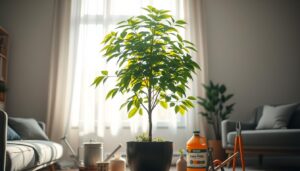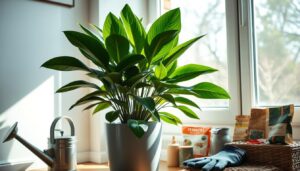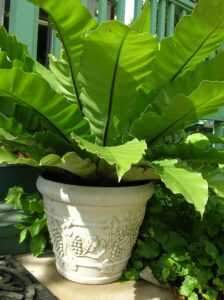
First choices in creating a Pet Friendly Beautiful and Creative Home that you will enjoy designing.
Welcome to “Trusted House Plant Guide,” where we celebrate the joy of integrating the green splendor of houseplants into homes filled with the love of pets. Whether you’re a proud cat mom, a devoted doggie daddy, or a nurturing guardian to any furry, feathered, or finned family member, you’re in the right place. Our guide is here to show you how the addition of houseplants can not only beautify your space but also enhance the quality of life for you and your beloved pets.
In a home where pets are considered part of the family, every decision we make, from decor to daily routines, often revolves around their well-being. Houseplants are no exception. The lush leaves and vibrant blooms of indoor plants can bring a new dimension of beauty and vitality to your living space. But more than that, they can create a healthier, more inviting environment for both you and your pets.
Imagine a space where the air is fresher, the ambiance calmer, and the connection to nature more tangible. Houseplants offer all these benefits and more. They are not just decorative elements; they are companions in their own right, contributing to a serene and healthful atmosphere. In this article, we’ll delve into why incorporating houseplants into your home is a wonderful decision for pet parents. We’ll highlight pet-safe plants like the Parlor Palm, Peperomia, and Bird’s Nest Fern, ensuring that your green additions are as safe as they are stunning.
So, let’s embark on this journey together, exploring how houseplants can create a harmonious, healthful, and beautiful living space for you and your cherished pets. Embrace the world of houseplants and discover how these natural wonders can make your home a happier place for every member of your family – on two legs or four, with fur or feathers. Welcome to a greener, pet-friendly living!
Section 1: Why Houseplants? Understanding Their Impact
Did You Know?
- Air Quality Improvement: Did you know that houseplants can significantly improve the air quality in your home? They act as natural air purifiers, removing toxins and emitting oxygen.
- Stress Reduction: Did you know that the presence of houseplants can reduce stress and anxiety levels? Studies have shown that being around greenery has a calming effect on the mind.
- Enhanced Focus and Productivity: Did you know that having plants in your home or workspace can enhance focus and productivity? The serene presence of plants has been linked to increased concentration and improved mental clarity.
- Therapeutic Effects: Did you know that the act of caring for plants can have therapeutic effects? Gardening, even on a small scale, is a mindful activity that can promote mental well-being.
- Aesthetic Appeal: Did you know that houseplants can dramatically elevate the aesthetic appeal of your living space? They bring a vibrant, refreshing touch of nature indoors.
Exploring the Benefits in Detail
Now that we’ve touched upon some fascinating facts about houseplants, let’s delve deeper into each of these benefits:
- Air Quality Improvement: Plants like the Parlor Palm are not just decorative; they are natural air purifiers. They absorb carbon dioxide and release oxygen, but that’s not all. Houseplants can also remove harmful toxins like formaldehyde and benzene from the air, making your home environment healthier for you and your pets.
- Stress Reduction: The calming green of houseplants can transform your home into a tranquil sanctuary. Studies have consistently shown that the presence of plants reduces stress levels, lowers blood pressure, and promotes a sense of well-being. This is especially beneficial in today’s fast-paced world, where finding peace can be a challenge.
- Enhanced Focus and Productivity: Incorporating plants into your home office or workspace can do wonders for your focus and productivity. The serene and natural ambiance created by plants like Peperomia helps in maintaining a calm and concentrated mindset, essential for effective work and creativity.
- Therapeutic Effects: Engaging with houseplants, be it watering, pruning, or simply observing their growth, is a form of mindfulness. This interaction is not just a hobby; it’s a therapeutic activity that can enhance your mood, improve your mental health, and provide a sense of achievement.
- Aesthetic Appeal: Finally, the aesthetic value of houseplants like the Bird’s Nest Fern cannot be overstated. They add color, texture, and life to any room, making your living space more inviting and vibrant. Whether you prefer a minimalist look with just a few plants or a lush indoor jungle, houseplants can cater to every style.
Incorporating houseplants into your home is more than just a decor choice; it’s a step towards a healthier, more fulfilling lifestyle. As we move forward, keep in mind that the right choice of plants can ensure that your green companions are safe and enjoyable for both you and your pets.
Section 2: Pet Safety & Plant Selection: Finding Harmony
As pet parents, we understand that every addition to our home must be vetted for safety and compatibility with our furry, feathered, or finned family members. This is especially true when it comes to choosing houseplants. The good news is, having pets doesn’t mean you have to forego the joys of indoor gardening. There are numerous pet-friendly plants that can coexist beautifully with your animal companions. Let’s explore why it’s essential to choose the right plants and introduce you to three stars of the pet-friendly houseplant world: the Parlor Palm, Peperomia, and Bird’s Nest Fern.
Understanding Pet-Friendly Plants
Before we dive into our plant stars, let’s talk about what makes a plant pet-friendly. A pet-friendly plant is one that is non-toxic and safe for pets if they decide to nibble on a leaf or two. While it’s always a good practice to keep plants out of reach of pets, accidents can happen, and choosing plants that won’t harm your pet is crucial.
Now, let’s meet the plants that are not only safe for your pets but also easy to care for and beautiful to look at!
-
Parlor Palm
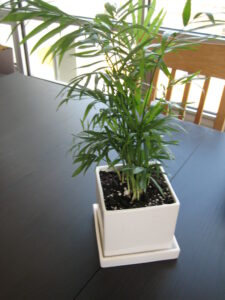
Parlor Palm (Chamaedorea elegans)
The Parlor Palm is a true gem for pet owners. It thrives in low light and is incredibly easy to care for, making it perfect for beginners. This palm adds a touch of tropical elegance to any room and is completely safe for cats and dogs. Its ability to filter indoor air pollutants also makes it a healthy choice for your home environment.
-
Peperomia
Peperomia plants come in various shapes and colors, offering a wide range of options for indoor gardeners. These plants are known for their ease of care, making them ideal for busy pet parents. Most importantly, Peperomias are non-toxic to both cats and dogs, allowing you to decorate your home with these charming plants without worry.
-
Bird’s Nest Fern (Asplenium nidus)
Lastly, the Bird’s Nest Fern is a fantastic choice for a pet-friendly household. This fern adds a lush, green touch with its crinkly leaves and unique shape. It’s great for adding texture and depth to your indoor garden. Bird’s Nest Ferns are safe for pets and thrive in humid environments, making them perfect for bathrooms or kitchens.
In the following sections, we’ll delve deeper into each of these plants, exploring their specific care requirements and how they can enhance your home. Stay tuned to learn more about creating a beautiful, safe, and healthy environment for you and your pets with these wonderful houseplants.
Section 3: Parlor Palm – A Perfect Starter Plant for Pet Owners
Are you looking for your first houseplant? The Parlor Palm is an excellent choice for beginners, especially if you have pets at home. Native to the rainforests of Central America, the Parlor Palm (Chamaedorea elegans) is renowned for its ease of care, tolerance to low light conditions, and non-toxicity to both cats and dogs.
Why Choose Parlor Palm?
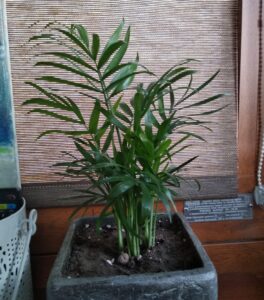
- Low Maintenance: Parlor Palms require minimal care. They thrive in indirect light and only need watering when the top inch of soil feels dry.
- Air Purifying: This palm is known for its air-purifying qualities, removing indoor air pollutants and improving air quality.
- Pet-Safe: Most importantly, Parlor Palms are safe for your furry friends. They pose no risk if your curious cat or dog decides to take a nibble.
Caring for Your Parlor Palm
- Place your Parlor Palm in a spot with moderate, indirect sunlight.
- Water sparingly, allowing the soil to dry out slightly between waterings.
- It prefers humidity but can tolerate drier indoor conditions.
Section 4: Peperomia – The Pet-Friendly and Versatile Plant
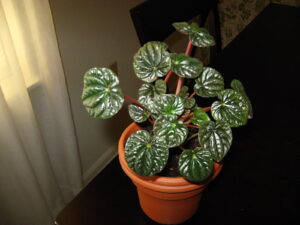 If you’re venturing into the world of houseplants, Peperomia is a fantastic option to consider. With over 1000 species to choose from, these plants offer a variety of textures, colors, and shapes, making them a delightful addition to any plant collection. Plus, they’re completely safe for your pets!
If you’re venturing into the world of houseplants, Peperomia is a fantastic option to consider. With over 1000 species to choose from, these plants offer a variety of textures, colors, and shapes, making them a delightful addition to any plant collection. Plus, they’re completely safe for your pets!
Why Choose Peperomia?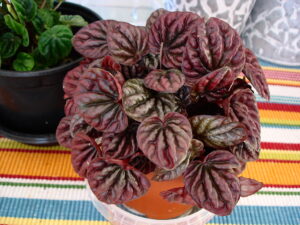
- Variety: There are over 1,000 varieties of this beautiful species. From the rubbery leaves of Peperomia obtusifolia to the watermelon-striped Peperomia argyreia, there’s a Peperomia for every taste.
- Easy Care: These plants are low-maintenance, making them ideal for beginners.
- Safe for Pets: All species of Peperomia are non-toxic to cats and dogs.
Caring for Your Peperomia
- Peperomias prefer bright, indirect light but can adapt to lower light levels.
- Allow the soil to dry out between waterings.
- They enjoy a moderate to high humidity environment but can adapt to typical household humidity.
Section 5: Bird’s Nest Fern – A Lush Addition to Your Pet-Safe Garden
For those looking to start their plant journey with something uniquely beautiful, the Bird’s Nest Fern is an excellent choice. This fern is known for its crinkly, apple-green leaves and adds a touch of the tropics to any space. What’s more, it’s completely safe for your pets!
Why Choose Bird’s Nest Fern?
- Aesthetic Appeal: Its distinctive fronds make it a visually appealing plant.
- Easy to Grow: Bird’s Nest Ferns are relatively easy to care for, thriving in indirect light and humid conditions.
- Pet-Friendly: This fern is non-toxic to both cats and dogs, making it a worry-free choice for pet owners.
Caring for Your Bird’s Nest Fern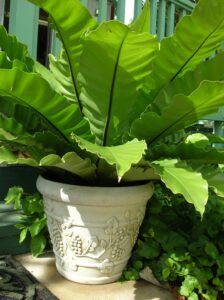
- Place it in a spot with indirect, filtered light. Avoid direct sunlight.
- Keep the soil consistently moist but not soggy.
- Bird’s Nest Ferns love humidity, making them perfect for bathrooms or kitchens.
Each of these plants offers a unique blend of beauty, ease of care, and safety for pets, making them ideal choices for first-time plant owners. Whether you choose the elegant Parlor Palm, the diverse Peperomia, or the lush Bird’s Nest Fern, you’re sure to find a fulfilling and rewarding experience in the world of houseplants.
Section 6: Embracing Versatility and Health with Pet-Friendly Plants
Creating a home filled with pet-friendly plants is not just about safety; it’s an adventure in design, health, and well-being. The Parlor Palm, Peperomia, and Bird’s Nest Fern are not just safe choices for your pets; they offer a canvas for creativity, a boost to your health, and a variety of textures and colors to play with. Let’s explore the fun and versatility these plants offer to your home, crafting the healthiest and most vibrant environment you’ve ever experienced.
Designing with Pet-Safe Plants
- Mix and Match: With the variety of shapes and sizes that these plants offer, you can create a visually stunning indoor garden. Use the tall and elegant Parlor Palm as a statement piece in your living room. Add varieties of Peperomia on shelves or desks for a pop of color and texture. The Bird’s Nest Fern can be an excellent addition to humid areas like bathrooms, where its lush fronds will thrive.
- Creative Containers: Choosing unique pots and planters can add an extra layer of style to your indoor garden. Experiment with different materials like ceramic, wood, or recycled materials to reflect your personal style.
- Level Up with Layers: Use plant stands of varying heights to create a multi-tiered display, adding depth and interest to any room.
Health Benefits in Every Corner
- Air Purification: These plants do more than just beautify your space; they actively purify the air. Parlor Palms are particularly good at filtering out common household toxins, contributing to a healthier living environment.
- Stress Relief: The act of caring for plants, watching them grow and flourish, is incredibly soothing. It’s a peaceful, grounding experience that can reduce stress and improve mental well-being.
Fun with Functionality
- Interactive Spaces: Create areas in your home where your pets can safely interact with the plants. A low shelf with a few Peperomia plants can become a fascinating spot for your cat or dog to explore.
- Seasonal Shifts: Have fun changing your plant arrangements with the seasons. Move plants around to catch different light, or add seasonal decor to keep your space fresh and exciting.
Incorporating pet-friendly plants into your home is more than just a hobby; it’s a lifestyle choice that brings health, joy, and beauty into your daily life. With these versatile and safe plant options, you can unleash your creativity, designing a space that is both invigorating and harmonious for you and your pets. Embrace the fun, experiment with different setups, and watch as your home transforms into a thriving, pet-safe plant paradise.
Conclusion: Embarking on a Journey of Greenery and Joy
As we wrap up this exploration into the world of pet-friendly houseplants, we hope you’re feeling inspired and excited about the journey ahead. Remember, introducing plants like the Parlor Palm, Peperomia, and Bird’s Nest Fern into your home is more than just a decorating move – it’s about creating a playful, vibrant environment that benefits both you and your pets.
Think back to those times of rearranging your home, the curiosity and excitement in your pet’s eyes as each new plant found its place. This is the joy and energy boost that awaits you as you embark (no pun intended, dog lovers!) on this creative adventure. Houseplants offer a unique way to connect with nature, enliven your space, and provide a healthy, stimulating environment for your furry friends.
As you start this journey, remember that the Trusted House Plant Guide is here to support you every step of the way. For more great information and inspiration, be sure to bookmark TrustedHousePlantGuide.com. And for an even more fun and interactive experience, join us on our YouTube channel at Gardening TLC.
Here’s to the start of a truly creative and enjoyable experience with your pets and plants. Thank you for joining us on this green adventure.
With love and green thumbs up from Michelle and Glenn!
Here are some recommended products for you to consider as you build your tool kit of resources: These are products that we receive a small commission on which are recommended to you at the same or lower price that you will find anywhere,
Thanks Again and Hope to See You Soon! Check out our video on Pet Friendly HousePlants!
- Pet-Safe Fertilizers: Recommended Look for organic, non-toxic options.
- Plant Watering Systems: For beginners, watering can be tricky. Simple start and grow into anything deeper.
- Decorative Planters and Pots: These can range from modern, minimalist designs to more elaborate, decorative options, catering to various tastes.
- Indoor Plant Lights: If you are looking to enhance areas with little natural light. I recommend grow lights that can help keep their houseplants thriving.
- Misters- spray bottles: For plants like the Bird’s Nest Fern that thrive in humidity, products like humidity trays and misters would be useful.
- Books on Houseplant Care: You may appreciate this fun starter book on houseplant care, especially those focusing on pet-safe plants.
- Pet Barriers: To keep pets away from plants, suggested stylish but effective barriers or plant stands.
- Eco-Friendly Pest Control: Recommended natural pest control solutions that are safe for both plants and pets.
- Pruning Tools: For plant maintenance, include pruning shears or scissors that are safe.
If you Would Like to Michelle discussing this topic and many more visit her at our YouTube channel



